With so many vibrant, interesting, and scenic places in southern Spain, you might be wondering… is Malaga worth visiting? Well, you’ve landed in the right place.
In this guide, you’ll find all the information you need to decide if you should visit Malaga during your trip to Spain.
Is Malaga Worth Visiting?
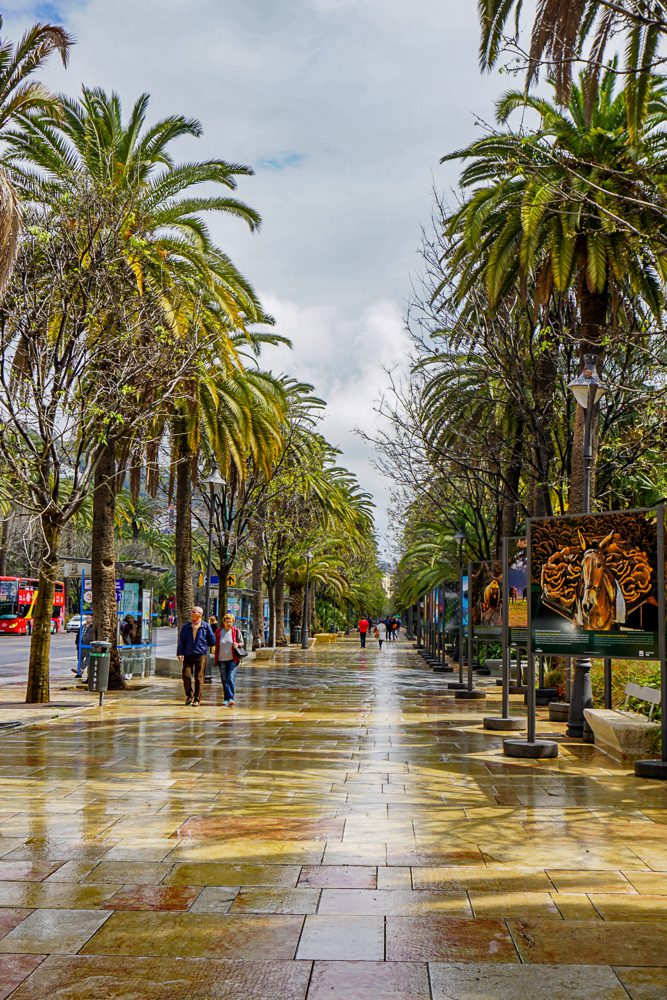
Malaga is a charming coastal city that has a mix of things to do, from lounging on the beach to exploring old ruins.
It’s a popular tourist destination year-round, which isn’t surprising since the weather is warm and sunny in the summer months and very mild in the winter compared to European destinations further north. In fact, Malaga gets roughly 300 sunny days per year!
This Spanish city was conquered by many different civilizations throughout its history. What’s left is a mix of architectural styles and a mosaic of stunning landmarks. It was first colonized by the Phoenicians in 1000 B.C. who named it Malaka. This also makes it one of the oldest cities in the world!
The name Malaka might have its roots in the Phonecian word Malac which means “to salt”. This would make sense as the Guadalhorce River they established the city along was an important fish-salting center.
Before Malaga came to be under Christian rule it was reigned over by the Greeks, Carthaginians, Romans, and Moors. It wasn’t until the Muslims were forced out of the city by the spreading rule of the Catholic Monarchs (known as the Reyes Catolicos, Queen Isabella I and King Ferdinand II) that Christianity began to take hold in the city.
Thankfully for today’s visitors to Malaga conquering and ever-changing rulers are a thing of the past! Malaga is a laid-back, budget-friendly, and beautiful place for a long stay or a passing visit.
What’s Left of Malaga’s History?
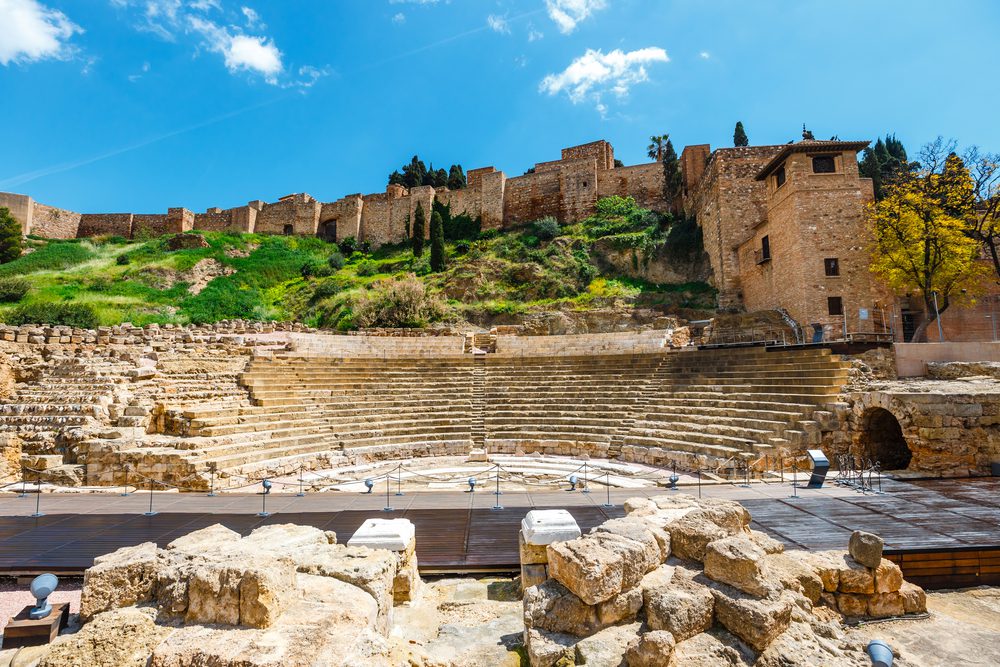
The many ancient civilizations that ruled over Malaga have each left an individual mark on the city, some of which you can still see today! While there isn’t much left from the pre-Roman settlements in the city, there’s a good amount of Roman and Moorish architecture in and around Malaga.
Needless to say, many of the first Christian churches built around the city are still standing today.
The most prominent remains of Roman architecture are; the Roman Theatre nestled in the city center, the Roman Ruins of Acinipo, the Roman Sulphur Baths of Hedionda (both of which are a little way out of the city), and a stretch of the old Roman city wall that is hidden inside a hotel!
If you’re looking to explore the Moorish history of the city, then the Malaga Alcazaba and Gibralfaro Castle are where you ought to be headed to. They’re close to one another too, which is very convenient.
Where is Malaga, Spain?
Malaga is in the south of Spain, in Andalucia. It’s the capital city of the Province of Malaga and acts as a gateway to many of the nearby cities. While it’s worth a visit in its own right, it’s also conveniently close to many of the other jewels of Andalucia, like the cities of Granada, Ronda, Cordoba, and Seville, and the region’s famed white villages. You can easily plan a southern Spain road trip that includes Malaga!
It’s a coastal city and it’s also surrounded by a backdrop of the gorgeous Sierra Nevada Mountains. Malaga is the capital of the Costa del Sol, which translates to the coast of the sun. So, you can expect Mediterranean weather, great beaches, and, of course, a bucketload of Andalusian culture.
Things to See and Do in Malaga

So, is Malaga worth visiting?
We just saw that Malaga has a rich history and a beautiful landscape, so yes, I think it’s definitely worth traveling to Malaga and spending some time. In all honesty, it was one of the biggest surprises (in a good way) when I visited! The city is perfect for anyone who loves food, history, culture, and the sea.
But in case you aren’t convinced yet, here’s a mix of what to do in Malaga, as well as all the things for which Malaga is famous. Ready to be convinced and build your Malaga itinerary?
Eat Tapas.
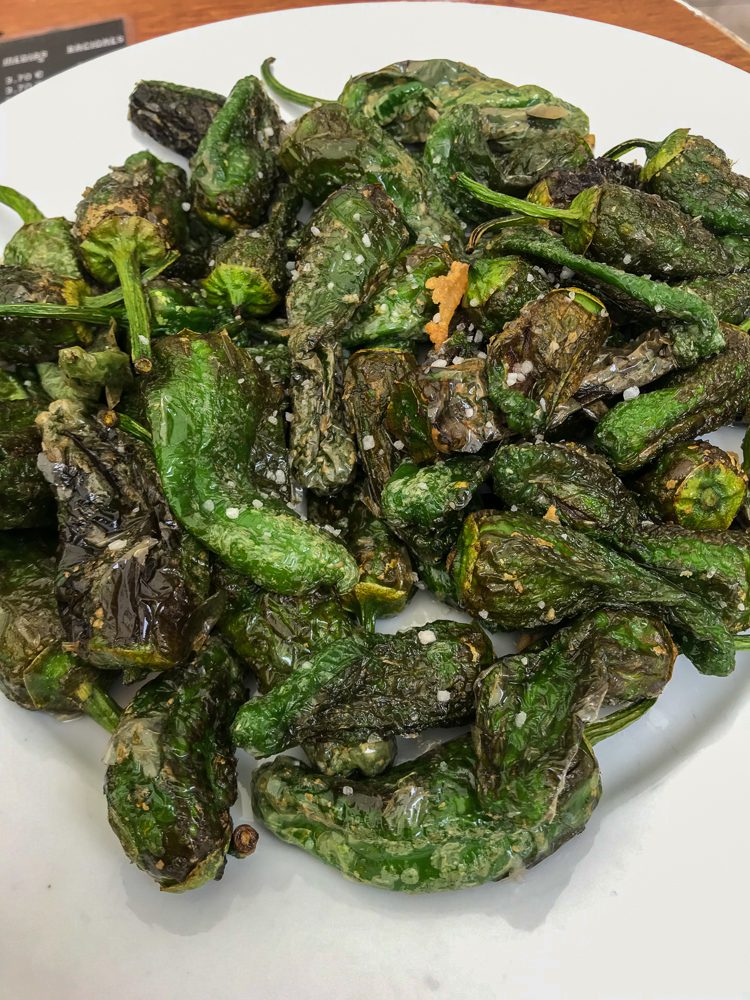
You can’t go to a city in Spain and not spend an evening hopping between bars, drinking cold beers, and eating tapas. Tapas used to be free across Andalucia, but sadly that only applies to the province of Granada now.
Tapas are essentially small plates of food usually featuring the region’s classic snack dishes. The most common things to be served as tapas are croquettes, tortillas, simple plates of ham and cheese, or olives with bread.
Malaga has some unique tapas dishes that are especially good, like their prawns pil pil (shrimp in an oil of garlic and chilis), montadito pringa (a miniature version of a meat sandwich), boquerones (fresh anchovies), berenjenas con miel de caña (battered and fried eggplant covered in cane sugar), and albóndigas en salsa de almendras (meatballs in almond sauce).
You’ll find that every bar you go into in Spain has tapas on the menu, and sometimes it’s the most understated and worn-down bars that have the best tapas. But if you’d rather not take your chances, here are some tapas bars that are guaranteed to be great:
- Uvedoble Tapas Malaga: Near the Roman Amphitheater but surprisingly a great place and not a tourist trap!
- Las Merchanas Malagas: Located in Malaga’s historic center…go when it opens to avoid a line.
- Marisqueria Casa Vicente: Tucked into a tiny street not far from the Paseo del Parque. Go for the seafood tapas!
- Tapeo de Cervantes: Just a 5-minute walk from the Picaso Museum with delicious, authentic food.
- La Tranca: Fantastic atmosphere and local cuisine! Don’t be surprised to find a line of people waiting to get in.
- Bodeguita El Gallo: A couple of minutes’ walk from the Plaza de la Merced…it’s cozy with typical dishes and drinks.
Remember that every plate of tapas should be accompanied by a caña, the preferred beer size of any local. When you first start drinking cañas you might wonder why they’re so small, but there is logic behind it. Southern Spain gets really hot, and to avoid the beers getting warm, locals drink lots of little beers instead of big glasses!
Another fun way to explore Malaga’s tapas scene is to join a guided tapas crawl with a local! Not only will you get to taste a variety of dishes, but you’ll also get some background on the city and its cuisine.
Stroll the Stunning Malaga City Center.
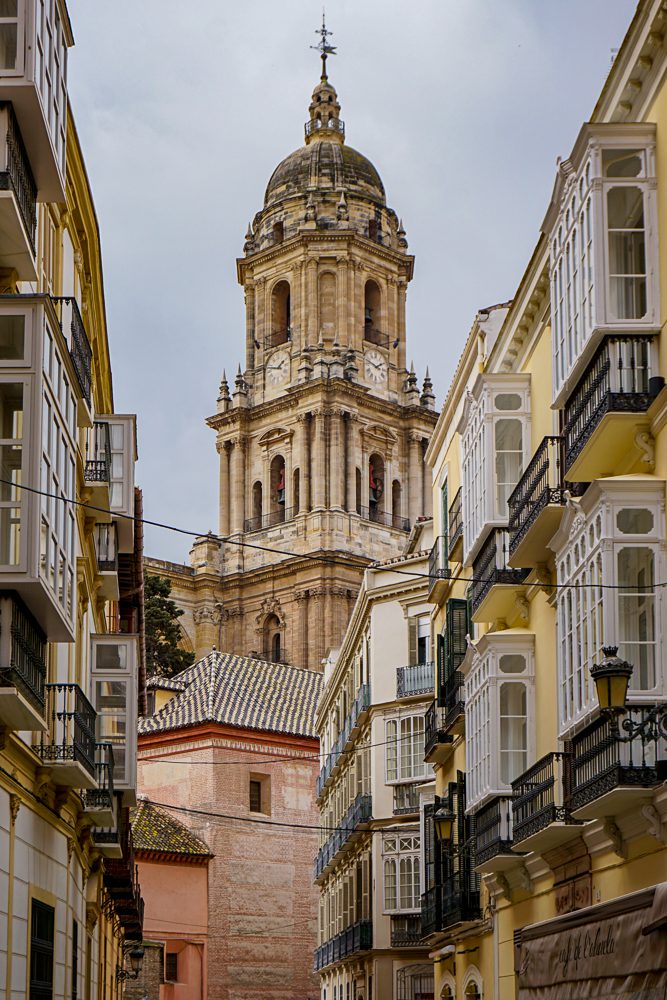
No Malaga visit is complete without an evening of wandering around the winding streets of the beautiful city center. The warm nights and lively atmosphere make the historic neighborhoods the best place to come for a late dinner, a few drinks, and a nightly walk.
Don’t miss the opportunity to walk along Calle Larios, Malaga’s most exclusive and expensive shopping street. Even if you don’t shop, the pedestrian area is one of the best places to stroll.
Wander past the many stunning buildings that have no name and the Malaga Cathedral in Plaza del Obispo, also known as “la manquita” or “one-armed lady” because it’s unfinished with only 1 tower instead of the planned 2 towers. The Cathedral is mostly Renaissance in style with Baroque touches. It also sits on the site of a former Mosque.
Check out the Roman Theater.

The old Roman Theater in Malaga wasn’t discovered until 1951, after remaining underground for nearly 2,000 years. It is thought to date back to the first century and was built during the Empire of Augustus.
Once the city was conquered by the Moors, parts of the amphitheater, like the column shafts and capitals, were repurposed and used in the construction of the Alcazaba fortress.
The theater was an important epicenter for entertainment in the city, but it was only used until the 3rd century. This grand theater had a radius of 31 meters and was once 16 meters tall!
Catch a Flamenco Show.
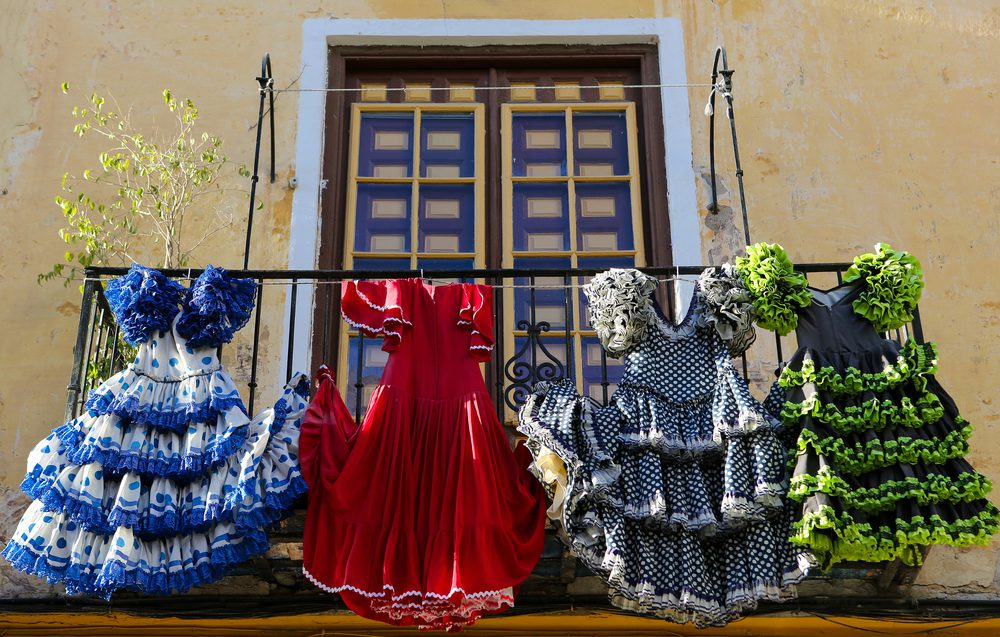
Flamenco is probably one of the first things you think of when you think of Spain. Ironically, it has its roots in India! Andalucia has a particularly strong connection to flamenco, and while cities like Seville are more known for their flamenco dancers, Malaga has plenty of places you can watch a flamenco show.
Watch the dancers whirl with passion at El Jardin Restaurante, a restaurant that serves delicious traditional food alongside their flamenco shows and is housed in an old building by the cathedral that dates back to 1887.
Catch a performance at the Restaurante Vino Mio, which has nightly flamenco shows from Wednesday to Sunday. Learn to clap your palms like the locals and let out a little “Ole” when things get exciting!
It’s also worth a visit to the Peña Juan Breva Flamenco Museum, which houses an impressive collection of century-old guitars, eye-catching flamenco dresses, and worn records, as well as hosting live flamenco shows.
If you’re lucky enough to be around for a flamenco festival, then make sure to get glammed up and join in!
Visit the Picasso Museum.
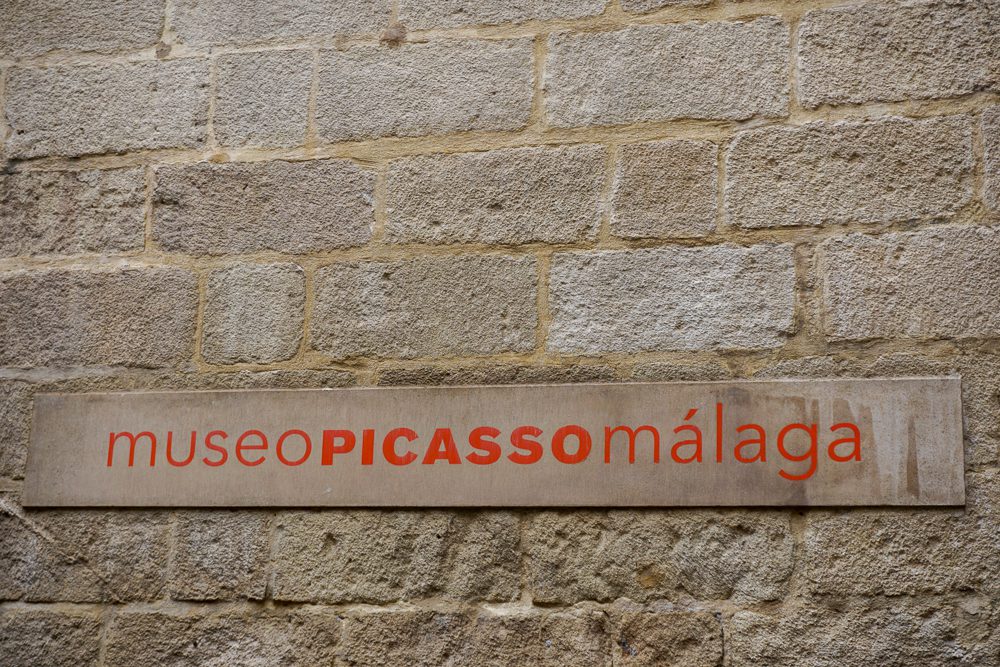
Of course, you can see Picasso’s work in many museums around the world but Malaga is where Pablo Picasso was born! So if you’re a fan of his work, it’s only right to pay homage to his works at the museum set up in his honor in his hometown.
The Picasso Museum sees flocks of art enthusiasts through its doors each day. It’s located in the heart of the city, in the historic center of Malaga, very close to the Cathedral of Malaga and other famous landmarks like the Roman Theater and the Alcazaba.
Picasso’s art is explored chronologically through some 200 pieces that are spread across the museum. From his simplest doodles to his most elaborate sculptures, you get a real sense of the range of artistic styles and materials that Picasso experimented with.
Some of the most iconic pieces held within the museum walls are “Woman Raised with Arms” and “Tended Bather”. There are other artists on display too, so there’s plenty to see.
Aside from the art, the Buenavista Palace that the museum is located in is worth a visit in its own right. It’s a prime example of the kind of architecture that was typical in Andalucia in the 16th century, with a mix of Renaissance and Mudejar running through the building. Plus, you can head to the basement and check out the Phoenician and Roman ruins that were recently recovered.
Purchase a ticket ahead of time to avoid waiting in line. If you manage to visit on a Sunday during the last two hours of opening, the museum is free!
Lounge on the Beach.
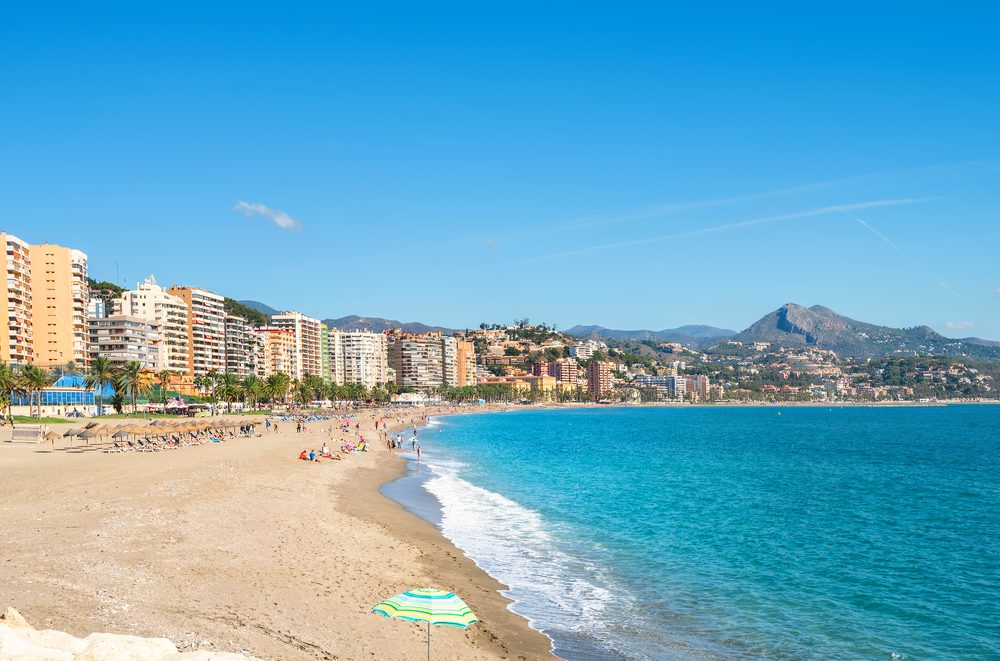
The palm trees and beaches on your doorstep are absolutely one of the perks of visiting Malaga over other Andalusian cities. It’s a great way to get a little beach time, especially if your southern Spain itinerary is busy!
Malaga is a port city so its beaches are not coveted as the finest in Spain. However, the beaches along the front of the city are sandy, close to tapas bars, and perfectly fine for a quick dip in the warm Mediterranean sea.
Bring a good book and spend a few hours lounging to catch that holiday tan! Beach bars await should you need a snack or something to drink.
If you’re looking for a beach close to the city center, then Playa La Malagueta is the easiest choice. Other popular beaches in Malaga are the Playa de La Caleta, the quieter Playa de el Palo, and the Playa Peñón del Cuervo which has a massive rock at the edge of its shoreline.
Alternatively, if you don’t mind driving a bit out of the city, then there’s a whole array of incredible destinations with beautiful beaches near Malaga. The quaint and charming towns of Nerja, Estepona, and famed destinations like Marbella are all among possible day trips from Malaga.
ProTip: Malaga’s port is the perfect place for a sunset stroll. Particularly in the summer, you’ll find food stalls, entertainment, and sometimes fireworks. There are nearby restaurants as well, but I’d recommend heading back into the old town for more authentic bites. If you prefer to take in the sunset from the sea, this catamaran trip is the way to go!
Visit the Malaga Alcazaba.
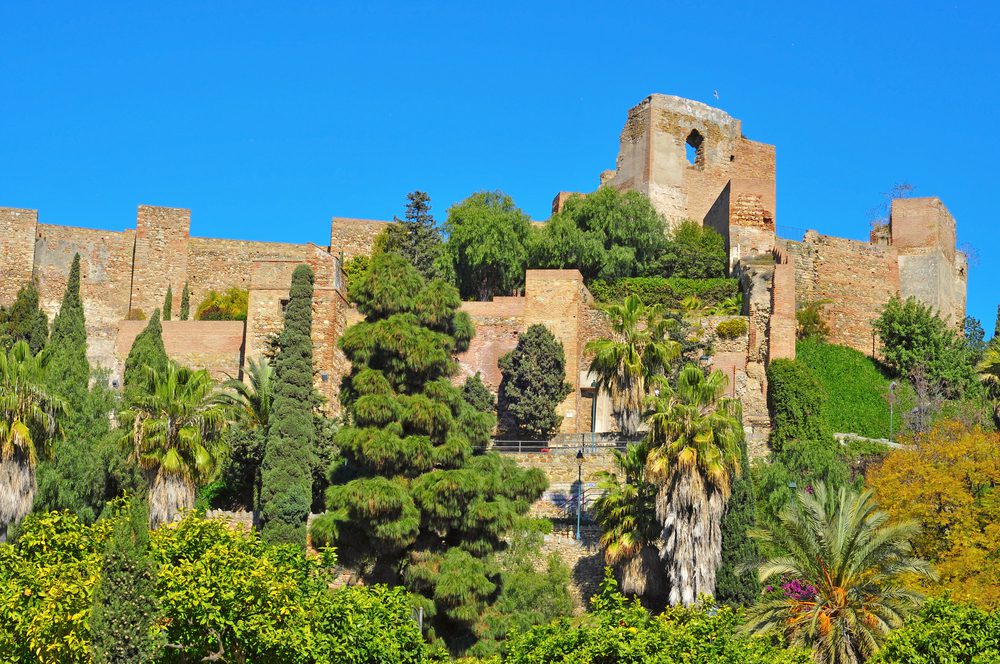
The Alcazaba was built between 1057 and 1063. It later became a part of the Nasrid Kingdom in 1279. Since then it’s undergone several different renovations that have made it the epic fortress it is today.
Unmissable and imposing, this old Moorish castle was strategically built on the Monte de Gibralfaro, giving it great views over the city. It’s near the ruins of the old Roman amphitheater and is easily accessible from the old town.
There were once three defense walls around the castle and 110 main towers! Walk around the remaining towers, like the Torre de la Vela, the Arco de Cristo, and the Torre Homenaje, to let your imagination run wild bringing ancient Malaga back to life.
The castle also has beautiful terraces, gardens, and courtyards with decorative pools you can stroll around.
If you prefer, go with a guide to explore the Alcazaba and learn more about its history.
Go to Castillo de Gibralfaro.
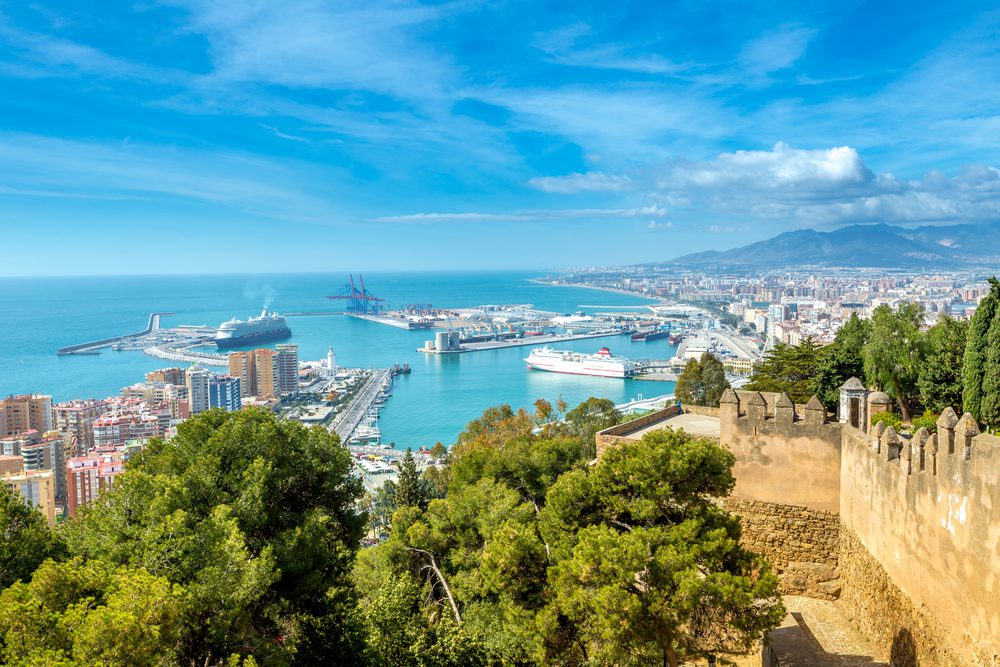
The Gibralfaro Castle is a medieval Moorish fortress that sits just above the Alcazaba on the Mount Gibralfaro summit. It was built in the 10th century where a Phoenician lighthouse once stood. Fittingly, the name Gibralfaro stems from the word “Gebel-faro” which means “rock of the lighthouse”.
The Sultan of Granada, Yusuf I, expanded the castle in the 14th century before it suffered the famous three-month siege at the hands of the Catholic Monarchs.
It was after being conquered by the Christians that King Ferdinand made the Gibralfaro Castle the emblem on the flag of both the province and city of Malaga.
Despite being under Christian rule for many centuries, there are still visible Islamic architectural features throughout the castle.
Because most of the intact parts of the castle are in the woodlands you can tie in your visit with a short nature walk, discovering the old ramparts along the way. There are incredible panoramic views of the sea and city from up there too!
Taste Local Specialities at Mercado Central de Atarazanas.
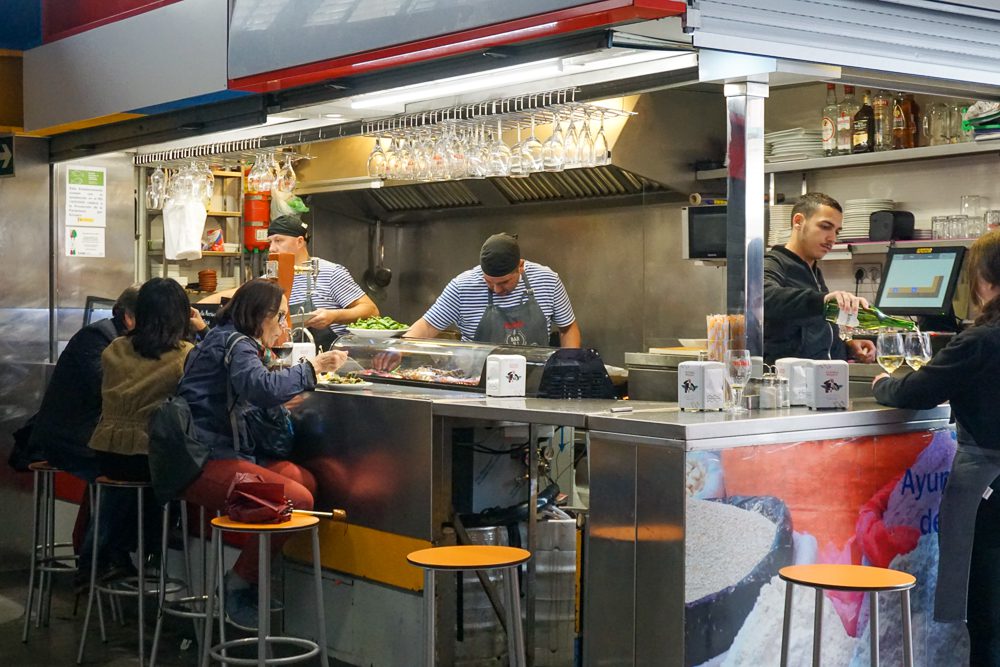
The Atarazanas market will delight all your senses and immerse you in the local culture. The building was once a shipyard and was built during the Nasrid period. Some features, like the grand arched gateway into the market, give away its Arabian origins.
Throughout its history, it’s been used as barracks and a military hospital, finally becoming a market in the 19th century. Most of the stalls have been passed down throughout the generations in the true family business style that is so prominent in Spain.
There are colorful products from the region, like tangy black olives, the finest olive oil, and hams, that you can buy to take home with you. The market is handily divided into three departments – fruit and vegetables, fresh fish, and meat.
Make sure you try the “Boquerones en vinagre” before you leave, and don’t be shy to practice your Spanish with the locals. The people in southern Spain are warm and welcoming and are always up for a chat!
Visit Malaga’s Museums.
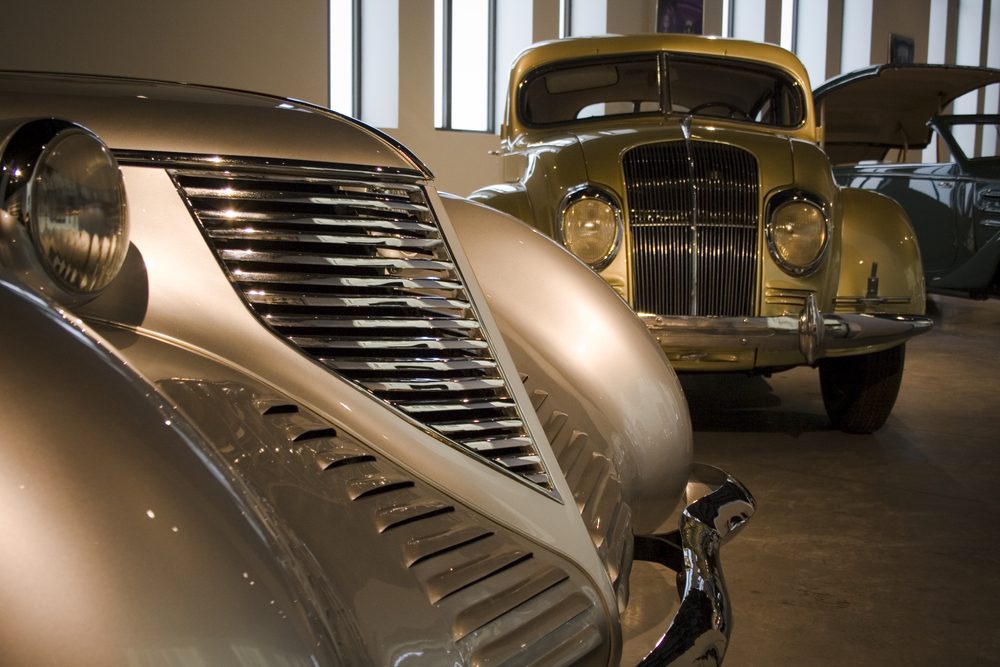
In addition to the Picasso Museum, Malaga has several museums that stand out for their uniqueness.
The Automobile and Fashion Museum contains hundreds of restored classic cars and a similar number of high fashion pieces that were worn by celebrities, Royals, and the like. Together, they highlight the artistic and historic changes that have happened over time since the 19th century. The museum is situated in the old Tobacco Factory and even non-car lovers will appreciate the amazing collection this museum has.
The Carmen Thyssen Museum has a curated collection of paintings from the past 200 years mostly done by Spanish and Andalusian artists. The museum spans 3 floors, with each floor containing art from specific periods. The collection, combined with the temporary exhibitions the museum hosts, are quite impressive and unlike other galleries you might find in Andalucia.
Even if the Museum of Glass and Crystal doesn’t sound appealing to you, allow me a moment to elaborate! This is a private museum set in a restored 18th-century house. You’ll find pieces of glass and crystal, but also on view are the pieces of furniture and paintings in the house. All visits are with a knowledgeable and enthusiastic guide who will take you on a 1-hour exploration through the house. I highly recommend a visit!
Relax at Hammam al Andalus.
One of the greatest traditions left behind by the Moors is their grand and luxurious hammam baths. Few across Spain compare to the majestic Hammam al Andalus in the city center of Malaga.
The building is built in a Moorish architectural style, with stunning patterned tiles lining the walls and impressive arches separating one room from the next. The ceilings are decorated with beautiful star-shaped skylights that let in a soothing orange light that twinkles against the water.
A soft silence fills the baths of al Andalus (the old Moorish name for Andalucia) and the pools soak all your stress away. A trip to the Hammam baths in Malaga is the perfect way to reset and slow down.
While you’re there, why not treat yourself and get a massage too?
Is Visiting Malaga Time Well-Spent?
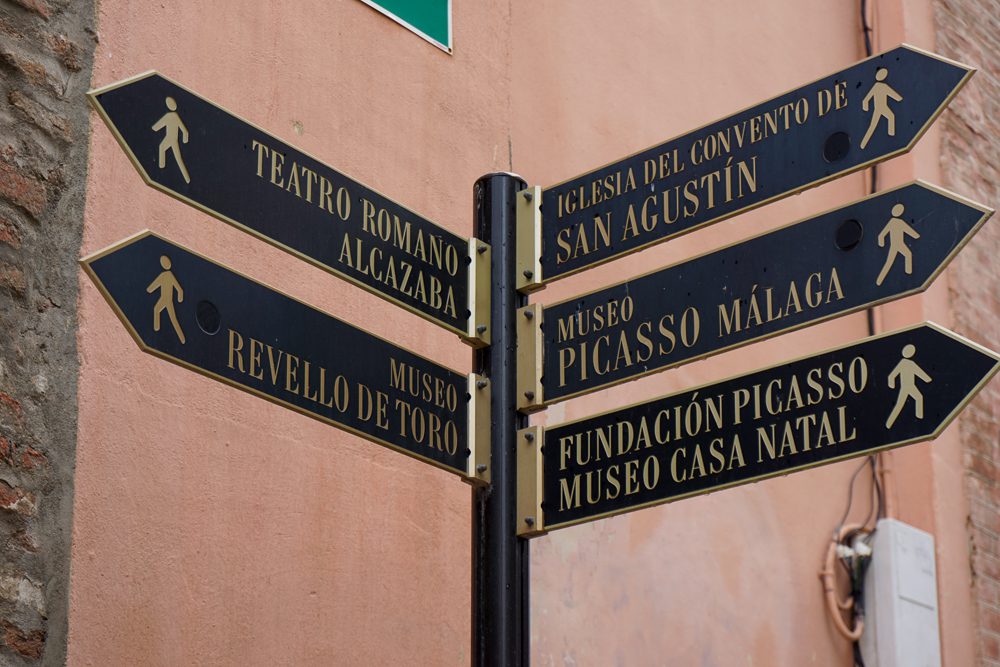
Hopefully, you’re now convinced that visiting Malaga is totally worth it, and perhaps you’re looking for a flight already!
Whatever time of year you go, and whatever your interest, Malaga has all the charms of Andalucia mixed with its own unique character that stems from its history and geography along the sea.
With so many Malaga hidden gems in plain sight(!), the sunny weather, and a welcoming community of locals, you’ll feel right at home and fall in love with this Andalusian coastal city.
So, what are your questions about visiting Malaga?
Like this post? Please share it using the social media buttons in this post.


